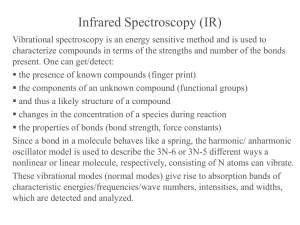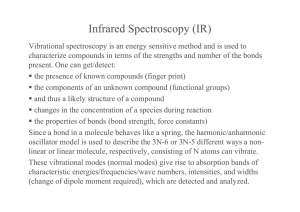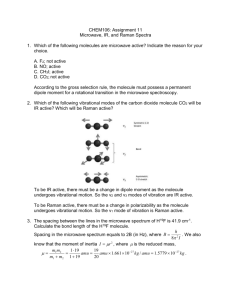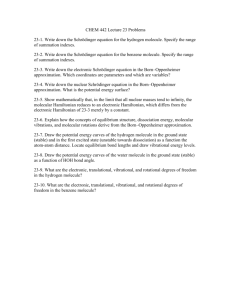3.014 Materials Laboratory Dec. 8 – Dec. 13 , 2006
advertisement
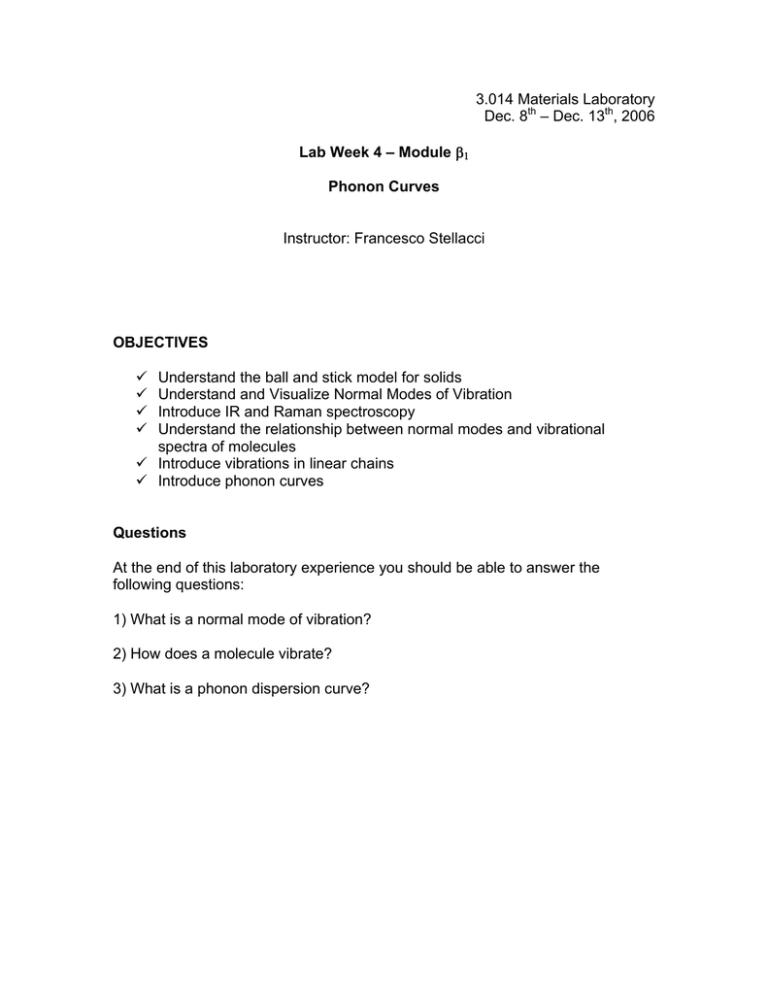
3.014 Materials Laboratory Dec. 8th – Dec. 13th, 2006 Lab Week 4 – Module β1 Phonon Curves Instructor: Francesco Stellacci OBJECTIVES 9 9 9 9 Understand the ball and stick model for solids Understand and Visualize Normal Modes of Vibration Introduce IR and Raman spectroscopy Understand the relationship between normal modes and vibrational spectra of molecules 9 Introduce vibrations in linear chains 9 Introduce phonon curves Questions At the end of this laboratory experience you should be able to answer the following questions: 1) What is a normal mode of vibration? 2) How does a molecule vibrate? 3) What is a phonon dispersion curve? Introduction The scope of this laboratory experiment is to understand excitations in molecules and solids. It is known that solids are constantly vibrating because of the thermal energy that they posses and because of interactions with external energy fonts (e.g. electromagnetic and sound waves). Also, remember that in quantum mechanics we have already seen that a particles in a potential cannot be at rest, thus particles are always oscillating. All solids can be thought as a series of balls (the atoms) kept together with springs (the chemical bonds). The mass of the balls is a simple function of the chemical nature of the atoms that compose the material, while the spring constant depends simply on the bond strength. This assumption not only allows for a substantial simplification of the analysis of vibration is solids but also helps with the understanding of the results of vibrational spectroscopic methods. This laboratory will first present oscillations in a series of masses connected with springs in order to provide tools for the analysis of vibration is complex system. The concept will then be immediately used to analyze the vibrations in oligo-methylenes chains. Finally a phonon curve will be constructed. Normal Modes of Vibration In order to understand vibrations in solids it is important to first understand vibrations in simpler systems such as a series of masses held together with springs. In particular the concept of normal modes has central importance in the analysis of all the problems that deal with molecular dynamics. Definition: Normal modes: are the vibrational modes that decouple the energy problem, i.e. they diagonalize the Hamiltonian of the system Let’s see what this means by considering a system of three identical masses (m) kept together by four spring of constant g as shown in figure 1. g g m x1 g m x2 g m x3 Figure 1. Schematic drawing of a series of equal masses held together by equal massless springs. The boxes at the extremes represent unmovable infinite masses. In order to solve the classical problem of the oscillations of these masses the first thing to do is to set a system of coordinates that conveniently describes the system. In this particular case we will assume that the masses can move only along the mass-mass direction, that is we will consider only the one dimensional problem. As shown in figure 1 the first choice that we can make is that of the “internal coordinates” a series of coordinates xi that describes the displacement of masses from their rest position. Classically this system can be solved by first writing its Hamiltonian in function of the three internal coordinates (x1, x2, x3) and of the three momenta of the particles (p1, p2, p3) 2 2 2 ( ) ( ) 2 2 p p1 p 1 1 1 1 + 2 + 3 + kx12 + k x2 − x1 + k x3 − x2 + kx32 2m 2m 2 m 2 2 2 2 where T and V are the total kinetic and potential energy of the system. H = T +V = (1) A complete solution of the system is then determined by solving the six differential equations ⎧ ∂H dxi ⎪⎪ ∂p = dt i ⎨ ∂H dp ⎪ =− i dt ⎩⎪ ∂xi with i = 1,2, and 3 ( 2) It should be evident that all of these equations will depend on at least 4 of the system variables. It can be shown that there always exists a linear combination of the internal coordinates called normal coordinates that generates a Hamiltonian that is simply the sum of the three independent Hamiltonians. A consequence of this is that the solution of the vibrational problem of the system becomes the solution of three simpler and independent problems. Each solution is a normal mode of vibration that is a vibration that happens at a given energy. In this particular problem by introducing the following variables ⎧ X = x1 − x3 ⎪Y = x − 2 * x + x 1 2 3 ⎪ ⎪⎪Z = x1 + 2 * x2 + x3 (3) ⎨ ⎪ P1 = p1 − p3 ⎪ P2 = p1 − 2 * p2 + p3 ⎪ ⎪⎩ P3 = p1 + 2 * p 2 + p3 it can be shown that the Hamiltonian becomes: Py Px P 1 1 1 + + z + kX 2 + kY 2 + kZ 2 = 2m 2m 2m 2 2 2 ⎛ P 1 ⎞ ⎛ Py 1 2 ⎞ ⎛ Pz 1 2 ⎞ = ⎜ x + kX 2 ⎟ + ⎜⎜ + kY ⎟⎟ + ⎜ + kZ ⎟ = H x + H y + H z ⎠ ⎝ 2m 2 ⎠ ⎝ 2m 2 ⎠ ⎝ 2m 2 H= (4) Each Hamiltonian can be solved independently and indeed the whole system can be solved by solving the three independent systems ⎧ ∂H dY ⎧ ∂H dX ⎧ ∂H dZ ⎪⎪ ∂p = dt ⎪⎪ ∂p = dt ⎪⎪ ∂p = dt y x z ; ; ⎨ (5) ⎨ ⎨ dp z dp dp ∂ H ∂ H ∂ H x y ⎪ ⎪ ⎪ =− =− =− ⎪⎩ ∂X ⎪⎩ ∂X ⎪⎩ ∂Y dt dt dt Each system will be solved by an equation of the type X = C exp(iωt ) (6) where C is a real number that specifies the vibrational amplitude of the normal mode and ω is the frequency of oscillation of the normal mode. To summarize: normal modes are those particular vibrational modes of a system that decouple the energy problem, that is they allow the separation of the Hamiltonian into independent Hamiltonians. (This property in linear algebra can be called orthogonalithy). Additionally, it can be showed that any system vibration is always a linear combination of normal modes. This classical derivation of the normal modes can be extended trivially in quantum mechanics simply changing the classical energy expression with the quantum mechanics operators. Even in that can it can be shown that the normal modes are the ones that allow for the separation of the Hamiltonian of the system into independent Hamiltonians. In quantum mechanics we know that frequency and energy are related by the relation E = hν = hcω (7 ) where ν is the frequency (expressed in s-1), while ω is the wavenumber (generally expressed in cm-1), h is Planck’s constant (6.626×10-34J s) and c is the speed of light in vacuum (2.99792458 ×1010 cm/s). Thus each normal mode has its own energy. Molecular Dynamics A molecule can be seen as an isolated system of atoms (masses) held together by forces around their equilibrium position. Let’s first look at a diatomic molecule. The energy that keeps the molecule together is shaped as illustrated in figure 2 E Ro R Figure 2. Schematic drawing of an energy-position plot for a diatom molecule. R represents the distance between the atoms. As shown from the red line near the equilibrium position (Ro) the energy barrier can always be approximated by a parabola and thus the bond can be treated like a spring. Around the equilibrium position the energy increases as the square of the displacement, that is the energy is that of a spring (or of a systems of springs) that holds the atom in place. As seen in 3.012 a particle in a square potential (linear harmonic oscillator) has quantized energy levels evenly spaced. These energy levels are the vibrational levels of the molecule. Their frequency of oscillation is determined by the difference in energy between the vibrational states as shown in figure 3. E hcυω ΔE = hν = hc R-Ro 1 1k μμ 22ππ K ν υ== Figure 3 Distribution of the vibrational energy levels in a linear harmonic oscillator. ν is the frequency expressed in s-1 while ω is the wavenumber expressed in cm-1. μ is the effective mass, while k is the spring constant Table 1 Stretching frequencies for some diatomic molecules H2 D2 μ (amu) 0.5 1.0 k (mdyne/Ǻ) 5.2 5.2 ω (cm-1) 4160 2940 HF HCl HBr HI 0.95 0.97 1.00 1.00 8.8 4.8 3.9 2.9 3950 2885 2559 2230 A polyatomic molecule composed of N atoms has 3N degrees of freedom of which 6 1 are the 3 translations and the 3 rotation of the molecule as a whole and thus do not change the relative distances between the molecules. The other 3N-6 are vibrational degrees of freedom of the molecules. For each degree of freedom there is a normal mode of vibration. While the energy-position plot of for a diatomic molecule is a two dimensional plot, the same plot for a polyatomic molecule becomes a (3N-6)+1 dimensional surface of a very complex shape. If this surface is sectioned by a plane that follows the displacement along a normal mode then (at least around the equilibrium position) the plot will look exactly like the one in fig.2. This is the beauty of normal mode formalism. Some normal modes are localized mostly on a few atoms and consequently are used to detect those atoms, while others are distributed along the whole molecule and thus can be used to extract information about the whole molecule. There are 2 main ways for probing the vibrations of a molecule or a solid: infrared spectroscopy and Raman spectroscopy. In the case of infrared spectroscopy an electromagnetic wave (photon) of energy comparable to that of the vibrational mode is sent to the sample and its absorption is probed. In the case of Raman spectroscopy an electro magnetic wave (photon) of energy much higher then the vibrational one is sent to the sample. The particle that is in one of the vibrational states gets excited and goes into a virtual state from which it immediately decays back, emitting another photon. In most cases the particle goes back into its original states (Rayleigh scattering) but in some cases the particles will decay in a different vibrational state. In such cases the difference in energy between the incoming and the emitted photons equals the vibrational energy. When the particle starts from the first vibrational state and decays to a higher vibrational state then we have a Stokes scattering event. When the particle starts from a higher vibrational states and decays in the first vibrational state then we have an anti-Stokes scattering event. 1 5 in the case of linear molecules. E R-Ro Figure 4 Schematic drawing of the three possible off-resonance interactions between an electromagnetic wave and an molecule. In the case of Rayleigh scattering a photon gets absorbed and immediately reemitted without gaining or loosing energy (left). In the case of anti-Stokes scattering a photon excites a particle that is in the first vibrational state. The particles then decays in the second vibrational state loosing energy (rigth). The opposite happens in Stokes scattering. (middle) In the case of infrared spectroscopy the interaction between the molecule and the electromagnetic wave can happen just if there is a change in molecular dipole during the vibration. For example let’s consider the molecule of chlorine (Cl2), while stretching this molecule does not change its dipole (that remains zero) thus it is not possible to excite this vibrational mode with an infrared photon. In the case of acid chloride (HCl), while stretching this molecule changes its dipole thus if irradiated with photon of the right energy this molecules will absorb them. In the case of Raman the situation is more complex and a vibrational mode can be excited just if the polarizability of the molecule changes. The polarizability is the ability of a molecule of forming a dipole in the presence of an applied electro-magnetic field. It is directly related to the ability of a molecule to freely move its electron. If we again consider the case of a chlorine molecule, while stretching the electron cloud that surrounds the molecule changes its shape and the more the two atoms are far from each other the more the electron acquire mobility and consequently polarizabilty. This vibrational mode can be detected in Raman spectroscopy. An interesting feature of Raman spectroscopy is that the intensity difference between the Stokes and the anti-Stokes lines depends only on the temperature and thus Raman spectrometers can be used as non invasive thermometers. The intensity of any give Raman peak is I anti − stokes = (ν o + ν vib ) Nυ1 a (ν ) (8) I stokes = (ν o −ν vib ) Nυ2 a (ν ) (9) 4 4 ν o wavenumber of the incident photon ν vib wavenumber of the vibration Nνi population of the ith vibrational state a (ν ) scattering cross − sec tion The population of a vibrational state is determined by Boltzmann statistics and thus the ratio between the population of the first and the second excited state is (using (7)) ⎛ −ΔE ⎞ ⎛ −hν vib ⎞ ⎛ −hcωvib ⎞ ⎛ −1.4388ωvib (cm−1 ) ⎞ Nν2 = exp ⎜ ⎟ = exp ⎜ ⎟ = exp ⎜ ⎟ = exp ⎜ ⎟ Nν1 T (K ) ⎝ ⎠ ⎝ k BT ⎠ ⎝ k BT ⎠ ⎝ k BT ⎠ (10) where k is the Boltzmann constant. By making the ratio of (9) and (8) and substituting (10) we obtain an expression that depends on T and on variables that can be measured in Raman spectra. Thus we can calculate T from the following expression: ⎛ −ΔE ⎞ ⎛ −hν vib ⎞ ⎛ −hcωvib ⎞ ⎛ −1.4388ωvib (cm−1 ) ⎞ Nν2 exp exp exp exp = = = = ⎜ ⎟ ⎜ ⎟ ⎜ ⎟ ⎜ ⎟ Nν1 T (K ) ⎝ ⎠ ⎝ k BT ⎠ ⎝ k BT ⎠ ⎝ k BT ⎠ (11) Linear Chains Some normal modes are localized on a few atoms while others are more delocalized over the whole molecule. Localized modes have been used for years as a tool to recognize unknown molecules. Here we focus on normal modes that are delocalized other a whole molecule and we use them as tools to build phonon dispersion curves. Let us consider again a diatomic molecule, as explained before its atoms oscillate along the molecular axis in a mode that is usually referred as a stretching mode. The frequency of vibration will be: 1 k (12) 2π μ where μ is the reduced mass, while k is the spring constant. If we now consider a triatomic molecule (e.g. CO2) there will be two stretching modes along the chain, one in which the two oxygens symmetrically and one in which the oxygens oscillate anti-symmetrically. These two modes of vibration can indeed be view simply as a linear combination of two stretching modes similar to the ones on the diatomic molecule. ν= A2 Q1 A3 Q2 Q1 A4 Q2 Q3 Figure by MIT OCW. Figure 5 Schematic drawing of the stretching modes along the molecular axis for polyatomic linear chains. For a given normal mode each atom is vibrating at the same frequency with a vibrational amplitude represented by the arrows. If we now consider a linear molecule made of 4 atoms we find three stretching modes along the molecular axis, even these modes can be seen as a linear combination of the stretching modes of a diatomic molecule. (fig. 5) A generic molecule of N identical atoms (A) has N-1 normal modes of vibration along the molecular axis they correspond to the linear combination of N-1 stretching modes of the A-A chemical bond. These modes can be described through a simple phase relationship between the amplitude of oscillations of neighboring atoms. In fact it can be rigorously shown that the phase relationship between the amplitude of oscillation (C is equation 6 ) of an atom i and that of the next atom i+1 is constant for these normal modes. For a given normal mode every atom will be oscillating at the same frequency ω, for example the ith atom will be oscillating according to the following formula: X i = Ci exp(iωt ) (13) In a normal mode the only thing that changes from atom to atom is Ci the oscillation amplitude. It can be shown that for a normal mode Ci = Ci −n cos nφ s (14) That is there is a constant phase difference between the oscillation amplitude of neighboring atoms. This phase changes form normal mode to normal modes. To explain this better we can look at the case of a linear chain of 8 atoms and look at the oscillation amplitudes of one of its normal modes (see figure 6). All of the atoms oscillate at a given frequency and in phase (they pass through the maxima of oscillation at the same time), but some atoms oscillate more then others. Notice that all of the atoms pass through their rest position at the same time, that is there are moments in time in which the chain is at rest. S=1 S=2 S=3 S=4 S=5 S=6 S=7 S=8 d Figure by MIT OCW. Figure 6 Schematic drawing of the amplitude of vibrations of the 8 atoms of a linear chain in all of the possible stretching modes along the molecular axis. The amplitudes of vibrations (represented by the arrows) are plotted perpendicular to the molecular axis for the sake of clarity, similarly the dotted line is drawn solely to help the reader identify the constant phase relationship.. It can be shown that for a linear chain on N atom the only possible phases are: π ( N − s) φs = s = 1, ..., N (15) N Each normal mode will have its own vibrational frequency and its own phase, the relationship between the vibrational frequency and the phase shift is call phonon dispersion curve. υ = f (φ s ) (16) Looking at the vibrational modes of a series of n-alkane molecules we will try to build the phonon dispersion curve of polyethylene. Bibliography “Vibrational intensities in infrared and Raman spectroscopy” ed. W. B. Person, G. Zerbi; Elsevier Scientific Pub., Amsterdam , 1982. R. G. Snyder, J. H. Schachtschneider, Spectrochimica Acta, 19, 85, 1963
